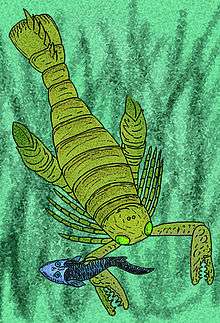Pterygotidae
| Pterygotidae Temporal range: Llandovery – Early Devonian | |
|---|---|
 | |
| Reconstruction of Acutiramus | |
| Scientific classification | |
| Kingdom: | Animalia |
| Phylum: | Arthropoda |
| Subphylum: | Chelicerata |
| Class: | Merostomata |
| Order: | †Eurypterida |
| Suborder: | †Eurypterina |
| Superfamily: | †Pterygotioidea |
| Family: | †Pterygotidae Clarke & Ruedemann, 1912 |
| Genera | |
|
See text | |
| Synonyms | |
|
†Jaekelopteridae Størmer, 1974 | |
Pterygotidae are an extinct family of eurypterids. They were members of the superfamily Pterygotioidea,[1] and were the only eurypterids to have a truly worldwide distribution,[2] and include the largest arthropods to have ever lived.
Description
Pterygotidae, which lived from the late Early Silurian to the Middle Devonian,[3][4] were characterized by small to large exoskeletons with semilunar scales. The telson, (tail) was expanded, or flatter than it was tall. Pterygotidae also had chelicerae (claws in front of the mouth) that were large and long, with strong, well developed teeth on the claws. Their walking legs were small and slender, without spines.[5] They were the largest arthropods to have ever lived; the largest described fragments shows individuals up to 540 cm in length.[6] Some of the pterygotids had reasonable binocular vision and chelicerae adapted for cutting or crushing, making them some of the most formidable predators of the Paleozoic. Others had poor eyesight and chelicerae more adapted to slicing, and so, most likely either scavenged or fed on soft-bodied organisms.[7]
Genera
- Class Merostomata Dana, 1852
- Order Eurypterida Burmeister, 1843
- Suborder Eurypterina Burmeister, 1843
- Superfamily Pterygotioidea Clarke & Ruedemann, 1912
- Family Pterygotidae Clarke & Ruedemann, 1912
- Genus Acutiramus Ruedemann, 1935
- Genus Ciurcopterus Tetlie & Briggs, 2009
- Genus Erettopterus Salter in Huxley & Salter, 1859
- Genus Jaekelopterus Waterston, 1964
- Genus Pterygotus Agassiz, 1839
- Family Pterygotidae Clarke & Ruedemann, 1912
Phylogeny
The genus Slimonia is thought to represent the sister group to the pterygotids.[8] Although the clade Pterygotidae is one of the best supported within the Eurypterida, relationships within the clade have been difficult to resolve.
| ||||||||||||||||||||||||
| The interrelationships of the pterygotids, based on studies by Braddy et al.[8] and Tetlie and Briggs;[3] the synapomorphies are as follows: |
References
- ↑ Alfred S. Romer (1993). "Eurypterid influence on vertebrate history". Science. 78 (2015): 114–117. doi:10.1126/science.78.2015.114. PMID 17749819.
- ↑ O. Erik Tetlie (2007). "Distribution and dispersal history of Eurypterida (Chelicerata)" (PDF). Palaeogeography, Palaeoclimatology, Palaeoecology. 252 (3–4): 557–574. doi:10.1016/j.palaeo.2007.05.011.
- 1 2 O. Erik Tetlie & Derek E. G. Briggs (2009). "The origin of pterygotid eurypterids (Chelicerata: Eurypterida)". Palaeontology. 52 (5): 1141–1148. doi:10.1111/j.1475-4983.2009.00907.x.
- ↑ D. E. G. Briggs; R. A. Fortey; E. N. K. Clarkson (1998). "Extinction and the fossil record of arthropods". In Gilbert Powell Larwood. Extinction and survival in the fossil record. Systematics Association. pp. 171–209. ISBN 978-0-19-857708-9.
- ↑ L. Størmer (1955). "Merostomata". Treatise on Invertebrate Paleontology, Part P Arthropoda 2, Chelicerata. p. 23.
- ↑ http://images.rom.on.ca/public/index.php?function=browse&action=result&filter=sc_coll&catid=77&areaid=73&sid=&ccid=
- ↑ McCoy, Victoria E., James C. Lamsdell, Markus Poschmann, Ross P. Anderson, and Derek E. G. Briggs. "All the better to see you with: eyes and claws reveal the evolution of divergent ecological roles in giant pterygotid eurypterids." Royal Society Publishing. 19 Aug. 2015. Web. <http://rsbl.royalsocietypublishing.org/content/11/8/20150564>.
- 1 2 Simon J. Braddy, Markus Poschmann & O. Erik Tetlie (2008). "Giant claw reveals the largest ever arthropod". Biology Letters. 4 (1): 106–109. doi:10.1098/rsbl.2007.0491. PMC 2412931
 . PMID 18029297.
. PMID 18029297.